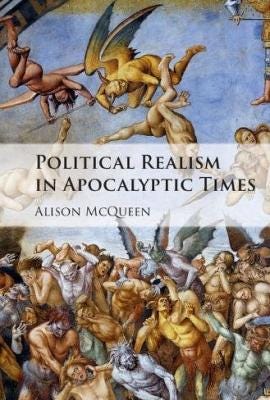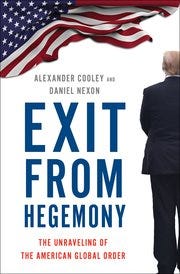About Systematic Organization
Welcome back after a long break. This newsletter covers my thoughts about the world of politics and the study of the world of politics. I’m an assistant professor of political science at the University of Massachusetts Amherst. The newsletter takes its title from a line in The Education of Henry Adams:
Politics, as a practice, whatever its professions, had always been the systematic organization of hatreds, and Massachusetts politics had been as harsh as the climate. The chief charm of New England was harshness of contrasts and extremes of sensibility—a cold that froze the blood, and a heat that boiled it—so that the pleasure of hating—one's self if no better victim offered—was not its rarest amusement; but the charm was a true and natural child of the soil, not a cultivated weed of the ancients.
Teaching and the End of the World
I concluded my time as an American Political Science Association Congressional Fellow last week. After a year preparing to be and then acting as a Capitol Hill staffer, it was a massive shift to come back to being a full-time academic.
It’s not like I was isolated from the effects of the pandemic. Like most offices, the one I worked for switched to full-time remote work in mid-March. Our work changed too as casework and pandemic response became consuming endeavors. But in a sense this was mostly the same kind of work that we had done in Longworth House Office Building, just being done from less elevated circumstances. (And in more comfortable clothing.)

Transitioning to online instruction in 2020. Jan Matsys, The Apocalypse of Saint John the Evangelist on the Island of Patmos, 1563.
Being on the Hill, however, meant that I missed the immense disruption in work life that my colleagues at UMass and elsewhere experienced as universities scrambled to transition to online learning. For nonteachers, online instruction may seem like a close substitute for in-person education; after all, in both cases, you’re just talking, right?
Well, no.
Online instruction is a fundamentally different beast than in-person instruction. In-person instruction is a live concert. When you’re doing well in in-person instruction, you’re not just delivering content—you’re engaging in a back-and-forth with the audience. There’s improvisation, clarification, and a host of performing tricks that keep the audience engaged. That’s not just true of seminar; it’s true of a large lecture class as well. (Sure, there are bad performers doing lectures who don’t do any of that, but that’s not the point.)
Online instruction is a music video. Everything needs to be planned and laid out ahead of time, and rolled out smoothly for the audience. Yes, you can do midcourse corrections, but it’s much harder. And most of the tricks that work for in-person instruction will fail in online content delivery. I notice all of this because over the past year I’ve been editing transcripts of my lectures from previous years’ in-person courses (a project that long predates Covid-19), and the degree of repetition, allusion, and you-had-to-be-there-ness of a good in-person lecture makes for messy transcripts indeed. Online scripts should be clean and don’t need to be repetitive: there’s a rewind button!
There’s also a much higher degree of technical skill involved in online educaiton. And I don’t just mean Zoom (although I understand that a lot of professors, and students, had a rough time there)—I mean a whole host of skills for making the most out of learning-management systems like Blackboard, Moodle, and Canvas, which are so user-unfriendly they make one yearn for DOS’s “abort, retry, fail” cycle. And complicating things further is that one can’t assume that one’s students will have the ability to access online resources from home.
All of this is to say that my re-entry into the academic work zone has been tougher than I thought it would be when I signed up to do a year away on fellowship. Instead of modestly updating two syllabi and preparing a third, I’m preparing weeks of entirely brand-new material for three syllabi that have to be entirely redone, while simultaneously getting ready to work with a mostly entirely new group of TAs that I’ve never met. It is a less than optimal time, and I’m fortunate enough to have a reasonably competent university administration.
The twist is that one of these courses is about current events: POLSCI 390, The Politics of the End of the World. (The link is to a very-much-in-progress syllabus draft.) This is an intensive course in which students basically do a full semester’s worth of reading and then work together in groups to create podcast episodes about the end of the world. (You can find the podcast from the first class here, and the official press release about the course is here.)
It’s a lot of work, and a ton of interaction. I wondered whether it was going to be too hard to do. Not only is working collaboratively over the Internet difficult, but the class will lose access to all of the on-campus equipment and materials that they use to do research and produce the class. But then I realized: there’s never been a better time to teach the course! How can you not teach a class on the end of the world right now—especially when the entire point of the course is to show how people make sense of and respond to challenging situations?
We will see how it works. (And you’ll have a chance to support these students soon, if you choose.)
What I’m Reading
This week, I’m featuring two very different books about the ends of the world.

The first is Stanford professor Alison McQueen’s Political Realism in Apocalyptic Times. McQueen argues that crucial figures in the Western political tradition of realism—Machiavelli, Hobbes, and Morgenthau—were more fired by the imperative of grappling with the end of the world than their later interpreters would have us believe. McQueen argues that how a culture perceives the end of the world will shape how they act politically in the present. Careful and interesting, McQueen’s book challenges conventional portraits of political theorists as immune from the cares of the world or the passions of the apocalypse.

The second is Exit From Hegemony: The Unraveling of The American Global Order by Columbia’s Alex Cooley and Georgetown’s Daniel Nexon. Cooley and Nexon argue that this time really is different—that this time forces within, below, and outside the American-led global order means that the U.S.-led order (“liberal” or not) will not survive much longer. In other words, it’s a book about the end of the world order.
From outside, China and Russia have the means and the will to challenge the Western-centric patronage order that has sustained and manifested hegemony. From within, the development of transnational activism has empowered many groups, especially on the right, that would like to overthrow the more liberal parts of the order. And from below, the emergence of alternative patrons for states like Venezuela and Saudi Arabia has hollowed out the foundations of the order. Despite the Trump-centric cover, their book makes clear that any U.S. president would, and will, have to manage relative decline because of these factors—Trump is an accelerant, not the initiator.


